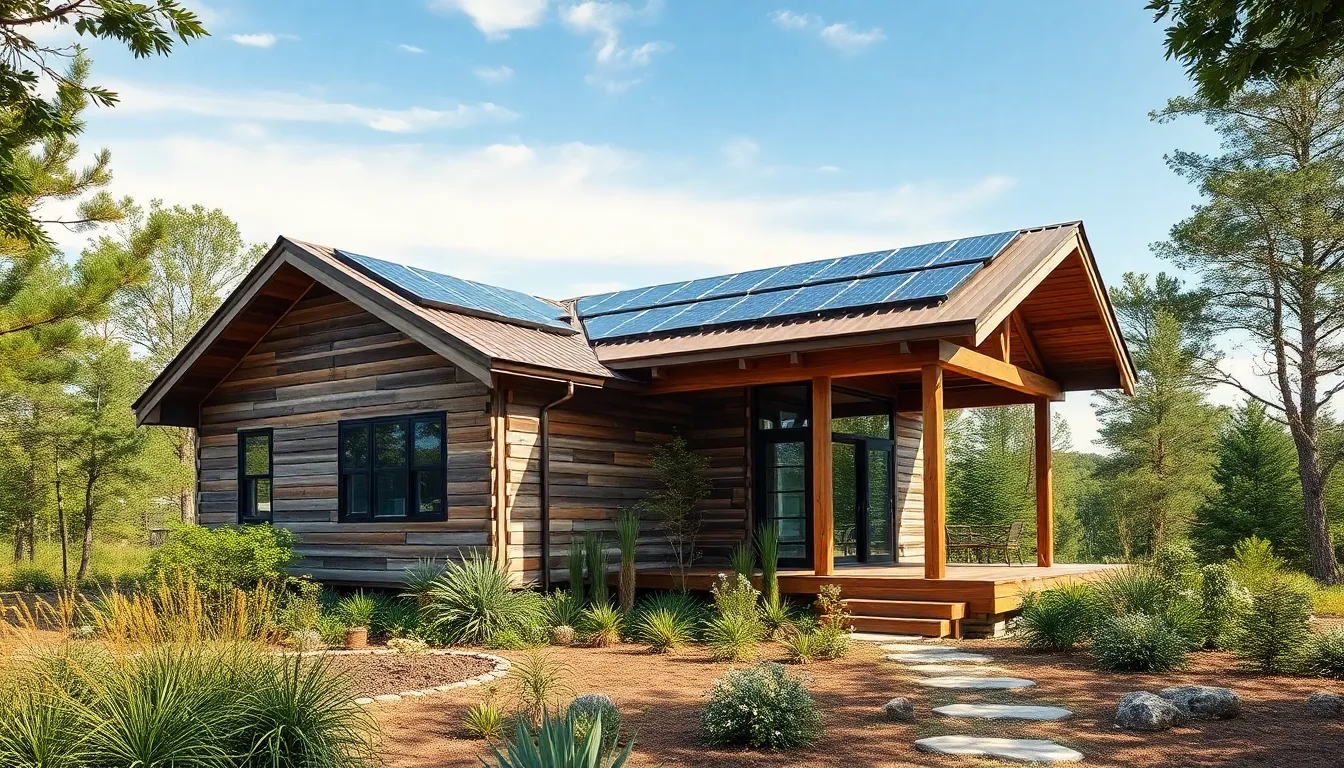In a world where the planet’s health often takes a backseat to convenience, eco-efficient designs are like superheroes swooping in to save the day. These innovative concepts don’t just look good; they work hard to minimize waste and energy use while maximizing sustainability. Imagine living in a home that’s not only stylish but also reduces your carbon footprint faster than you can say “green living.”
From energy-efficient appliances to sustainable materials, eco-efficient designs are the future of architecture and interior design. They offer a clever blend of functionality and environmental responsibility, proving that saving the planet can be chic and practical. So why not join the movement? After all, who wouldn’t want to impress friends with a home that’s as eco-friendly as it is trendy? Dive into the world of eco-efficient designs and discover how to make your space a little greener without sacrificing style.
Table of Contents
ToggleOverview of Eco-Efficient Designs
Eco-efficient designs focus on optimizing resource use while minimizing negative environmental impacts. These designs integrate sustainable materials that reduce energy consumption throughout their lifecycle. The adoption of renewable energy sources, like solar panels and wind turbines, plays a vital role in enhancing efficiency.
Architectural features such as green roofs and natural ventilation systems improve indoor air quality and reduce heating and cooling demands. Incorporating innovative insulation materials further increases energy efficiency, ensuring comfortable living spaces with lower energy bills.
Water conservation methods, including rainwater harvesting and low-flow fixtures, support sustainable living practices. Eco-efficient designs often incorporate drought-resistant landscaping, which not only conserves water but also promotes biodiversity.
Smart technologies enhance eco-friendly features, allowing homeowners to monitor usage patterns efficiently. Automated systems for lighting and temperature control contribute to sustainable energy management in residential and commercial spaces. These advancements reinforce the blending of style and functionality.
The integration of eco-efficient designs in urban planning creates healthier communities. Walkable neighborhoods, ample green spaces, and access to public transportation encourage reduced reliance on vehicles. Such designs contribute to lower greenhouse gas emissions and improve residents’ overall well-being.
Adopting eco-efficient designs signals a commitment to sustainable living. Developers, architects, and homeowners increasingly recognize the value of these designs, which remain attractive to environmentally conscious consumers. The continual evolution of these practices fosters innovation and keeps pace with advancements in technology and sustainability.
Key Principles of Eco-Efficient Designs

Eco-efficient designs prioritize a sustainable approach to architecture and space planning. They focus on reducing resource consumption and energy usage while enhancing aesthetic appeal.
Resource Efficiency
Resource efficiency emphasizes the optimal use of materials. Selecting sustainable resources like reclaimed wood or recycled metal minimizes environmental impact. Utilizing local materials reduces transportation emissions, creating a smaller carbon footprint. Incorporating modular construction techniques allows for efficient assembly and disassembly, making structures adaptable for future needs. Landscaping with native plants promotes biodiversity and requires less maintenance and water, directly influencing resource conservation. Deploying water-efficient appliances and fixtures also contributes to overall resource savings, ensuring responsible consumption across various areas.
Energy Efficiency
Energy efficiency focuses on reducing energy consumption throughout a building’s lifecycle. Installing solar panels generates renewable energy onsite, decreasing reliance on traditional power sources. Implementing high-performance insulation materials ensures thermal comfort while reducing heating and cooling needs. Natural ventilation systems allow fresh outdoor air to circulate indoor spaces, cutting down the need for mechanical cooling. Using energy-efficient lighting, such as LEDs, significantly lowers electricity use without compromising illumination quality. Smart home technologies provide real-time monitoring of energy consumption, encouraging inhabitants to adopt mindful energy practices that enhance overall efficiency.
Benefits of Eco-Efficient Designs
Eco-efficient designs provide significant benefits that enhance sustainability and reduce environmental harm. They contribute positively to ecological health while delivering practical and financial advantages.
Environmental Impact
Reducing carbon emissions plays a crucial role in eco-efficient designs. Energy-efficient buildings lower energy consumption, which decreases greenhouse gas emissions. Incorporating renewable energy sources like solar panels further lessens the reliance on fossil fuels. Improved air quality results from features like natural ventilation and green roofs, which promote better indoor environments. Water conservation strategies, including rainwater harvesting, curtail freshwater use and support sustainable water practices. Enhancing biodiversity occurs through the integration of drought-resistant landscaping, which provides habitats for local wildlife.
Economic Advantages
Cost savings emerge as a primary economic advantage of eco-efficient designs. Energy-efficient homes lead to lower utility bills, often resulting in substantial savings annually. Using sustainable materials can reduce long-term maintenance and replacement costs. Additionally, property values frequently increase due to the growing demand for eco-friendly features. Reduced environmental impact also aligns with government incentives, offering tax credits or rebates for homeowners adopting eco-efficient technologies. Investing in smart technologies enhances resource management, allowing homeowners to optimize their energy usage and realize further savings.
Challenges in Implementing Eco-Efficient Designs
Implementing eco-efficient designs presents various challenges that can hinder their adoption. High initial costs often deter developers and homeowners from integrating sustainable features. Limited access to quality sustainable materials can complicate the construction process.
Additionally, educational gaps exist among builders and consumers regarding eco-efficient technologies. Lack of knowledge leads to confusion about the benefits and proper implementation of these practices. Regulatory hurdles can also impede progress, as zoning laws and building codes may not support innovative designs.
Time constraints pose another significant challenge. Tight construction schedules often prioritize speed over sustainability, which can result in compromised eco-friendly practices. Furthermore, the availability of skilled labor in eco-efficient construction remains a concern. Skilled workers may lack training in new materials and methods that promote sustainability.
Cultural perceptions influence the acceptance of eco-efficient designs. Some individuals remain skeptical about the effectiveness of these technologies, often viewing them as unnecessary luxuries. Short-term thinking can overshadow the long-term benefits associated with sustainable practices, leading to resistance among stakeholders.
Ultimately, balancing aesthetics with functionality adds complexity to design decisions. Designers must consider how eco-efficient features integrate with the overall design vision without sacrificing style. Overcoming these challenges requires collaboration among architects, builders, and regulatory bodies to create supportive environments for eco-efficient designs. Engaging consumers through education and awareness can also foster a culture that embraces sustainable practices, paving the way for widespread adoption in the future.
Future Trends in Eco-Efficient Designs
Emerging technologies continuously reshape eco-efficient designs. Integrating artificial intelligence streamlines energy management within homes, allowing for real-time monitoring of consumption patterns. Advances in building materials contribute significantly to sustainability. Biodegradable composites and sustainable concrete are gaining popularity, reducing environmental harm during production and use.
Smart home systems enhance convenience while promoting energy savings. Homeowners control appliances and systems remotely, adjusting usage according to peak energy times. Urban environments are also evolving, with a focus on green architecture. Cities are implementing vertical gardens which purify air and provide urban greenery.
The concept of circular economy influences future trends. Designers prioritize reusing materials, minimizing waste throughout the lifecycle. Additionally, passive design principles gain traction, maximizing natural lighting and ventilation. This enhances occupant comfort while lowering energy needs.
Developments in renewable energy directly impact eco-efficient designs. Solar panels become more efficient with emerging technologies, and battery storage systems allow for energy independence. Furthermore, electric vehicle charging infrastructure is incorporating sustainable principles, facilitating transition to greener transportation options.
Collaboration between various stakeholders plays a critical role. Architects, builders, and city planners work together to create integrated, eco-friendly spaces. Educational programs increase awareness among communities, highlighting the importance of sustainability in design choices. Governments are introducing policies supporting eco-efficient developments, incentivizing the adoption of these designs across the board.
Adopting these practices shapes a sustainable future, promoting an eco-conscious lifestyle.
Embracing eco-efficient designs is essential for fostering a sustainable future. By integrating innovative technologies and sustainable materials, individuals can create spaces that not only look great but also contribute to a healthier planet. The shift towards eco-friendly living reflects a growing awareness of environmental responsibility.
As these designs continue to evolve, collaboration among architects, builders, and consumers will play a pivotal role in overcoming challenges. The commitment to sustainability is more than a trend; it’s a movement towards a more conscious way of living. With the right choices, anyone can contribute to a greener world while enjoying the benefits of stylish and efficient spaces.



